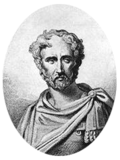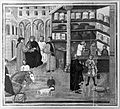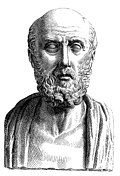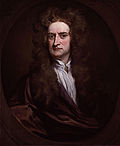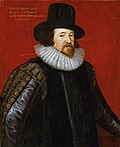Portal:History of science
The History of Science Portal
The history of science covers the development of science from ancient times to the present. It encompasses all three major branches of science: natural, social, and formal. Protoscience, early sciences, and natural philosophies such as alchemy and astrology that existed during the Bronze Age, Iron Age, classical antiquity and the Middle Ages, declined during the early modern period after the establishment of formal disciplines of science in the Age of Enlightenment.
Science's earliest roots can be traced to Ancient Egypt and Mesopotamia around 3000 to 1200 BCE. These civilizations' contributions to mathematics, astronomy, and medicine influenced later Greek natural philosophy of classical antiquity, wherein formal attempts were made to provide explanations of events in the physical world based on natural causes. After the fall of the Western Roman Empire, knowledge of Greek conceptions of the world deteriorated in Latin-speaking Western Europe during the early centuries (400 to 1000 CE) of the Middle Ages, but continued to thrive in the Greek-speaking Byzantine Empire. Aided by translations of Greek texts, the Hellenistic worldview was preserved and absorbed into the Arabic-speaking Muslim world during the Islamic Golden Age. The recovery and assimilation of Greek works and Islamic inquiries into Western Europe from the 10th to 13th century revived the learning of natural philosophy in the West. Traditions of early science were also developed in ancient India and separately in ancient China, the Chinese model having influenced Vietnam, Korea and Japan before Western exploration. Among the Pre-Columbian peoples of Mesoamerica, the Zapotec civilization established their first known traditions of astronomy and mathematics for producing calendars, followed by other civilizations such as the Maya.
Natural philosophy was transformed during the Scientific Revolution in 16th- to 17th-century Europe, as new ideas and discoveries departed from previous Greek conceptions and traditions. The New Science that emerged was more mechanistic in its worldview, more integrated with mathematics, and more reliable and open as its knowledge was based on a newly defined scientific method. More "revolutions" in subsequent centuries soon followed. The chemical revolution of the 18th century, for instance, introduced new quantitative methods and measurements for chemistry. In the 19th century, new perspectives regarding the conservation of energy, age of Earth, and evolution came into focus. And in the 20th century, new discoveries in genetics and physics laid the foundations for new sub disciplines such as molecular biology and particle physics. Moreover, industrial and military concerns as well as the increasing complexity of new research endeavors ushered in the era of "big science," particularly after World War II. (Full article...)
Selected article -

There were great innovations in metallurgy. In addition to Zhou-era China's (c. 1046 – 256 BCE) previous inventions of the blast furnace and cupola furnace to make pig iron and cast iron, respectively, the Han period saw the development of steel and wrought iron by use of the finery forge and puddling process. With the drilling of deep boreholes into the earth, the Chinese used not only derricks to lift brine up to the surface to be boiled into salt, but also set up bamboo-crafted pipeline transport systems which brought natural gas as fuel to the furnaces. Smelting techniques were enhanced with inventions such as the waterwheel-powered bellows; the resulting widespread distribution of iron tools facilitated the growth of agriculture. For tilling the soil and planting straight rows of crops, the improved heavy-moldboard plough with three iron plowshares and sturdy multiple-tube iron seed drill were invented in the Han, which greatly enhanced production yields and thus sustained population growth. The method of supplying irrigation ditches with water was improved with the invention of the mechanical chain pump powered by the rotation of a waterwheel or draft animals, which could transport irrigation water up elevated terrains. The waterwheel was also used for operating trip hammers in pounding grain and in rotating the metal rings of the mechanical-driven astronomical armillary sphere representing the celestial sphere around the Earth. (Full article...)
Selected image

This iconographic French tapestry from the early 16th century depicts the muse Astronomia consulting with an astronomer, possibly Ptolemy. The tapestry resides in the Röhsska Konstslöjdmuseet, but its origins are unknown.
Did you know
...that the word scientist was coined in 1833 by philosopher and historian of science William Whewell?
...that biogeography has its roots in investigations of the story of Noah's Ark?
...that the idea of the "Scientific Revolution" dates only to 1939, with the work of Alexandre Koyré?
Selected Biography -
Nikola Tesla (/ˈnɪkələ ˈtɛslə/; Serbian Cyrillic: Никола Тесла [nǐkola têsla]; 10 July 1856 – 7 January 1943) was a Serbian-American engineer, futurist, and inventor. He is known for his contributions to the design of the modern alternating current (AC) electricity supply system.
Born and raised in the Austrian Empire, Tesla first studied engineering and physics in the 1870s without receiving a degree. He then gained practical experience in the early 1880s working in telephony and at Continental Edison in the new electric power industry. In 1884 he immigrated to the United States, where he became a naturalized citizen. He worked for a short time at the Edison Machine Works in New York City before he struck out on his own. With the help of partners to finance and market his ideas, Tesla set up laboratories and companies in New York to develop a range of electrical and mechanical devices. His AC induction motor and related polyphase AC patents, licensed by Westinghouse Electric in 1888, earned him a considerable amount of money and became the cornerstone of the polyphase system which that company eventually marketed. (Full article...)
Selected anniversaries
- 1768 - Death of Georg Brandt, Swedish chemist and mineralogist (b. 1694)
- 1770 - James Cook arrives at and names Botany Bay, Australia
- 1793 - Death of John Michell, English scientist (b. 1724)
- 1798 - Death of Nikolaus Poda von Neuhaus, German entomologist (b. 1723)
- 1854 - Birth of Henri Poincaré, French mathematician and physicist (d. 1912)
- 1893 - Birth of Harold Urey, Nobel Prize laureate (d. 1981)
- 1916 - Death of Jørgen Pedersen Gram, Danish mathematician (b. 1850)
- 1966 - Death of William Eccles, English physicist and radio pioneer (b. 1875)
- 2008 - Death of Albert Hofmann, Swiss chemist, known as the first to synthesize LSD (b. 1906)
Related portals
Topics
General images
Subcategories
Things you can do
Help out by participating in the History of Science Wikiproject (which also coordinates the histories of medicine, technology and philosophy of science) or join the discussion.
Associated Wikimedia
The following Wikimedia Foundation sister projects provide more on this subject:
-
Commons
Free media repository -
Wikibooks
Free textbooks and manuals -
Wikidata
Free knowledge base -
Wikinews
Free-content news -
Wikiquote
Collection of quotations -
Wikisource
Free-content library -
Wikiversity
Free learning tools -
Wiktionary
Dictionary and thesaurus




